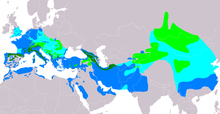Mountain pipit
| Mountain pipit | ||||||||||||
|---|---|---|---|---|---|---|---|---|---|---|---|---|

Mountain pipit in summer dress |
||||||||||||
| Systematics | ||||||||||||
|
||||||||||||
| Scientific name | ||||||||||||
| Anthus spinoletta | ||||||||||||
| ( Linnaeus , 1758) |
The mountain pipit ( Anthus spinoletta ) is a breeding bird of the high mountains of Central and Southern Europe and Asia Minor. With a total length of 17 centimeters, it is a relatively large representative of the genus Anthus . It is almost the size of a wagtail , but looks a bit more compact than this.
Mountain pipit are very closely related to the beach pipit and form a superspecies with it and the Pacific water pipit , which breeds in Central and East Asia as well as North America. Since mountain pipits are mostly found near water, especially in the winter months, they were (and are) also called water pipits .
description
Appearance
The mountain pipit is a slender and comparatively long-legged pipit with dark feet. In the splendid dress, the underside of the body is whitish with a pale rust-red breast. The beeper-typical stripes or dotted lines are almost completely absent or are only indicated diffusely, darker longitudinal lines can only be seen on the flanks. The back is gray-brown, the white stripe above the eyes is clear.
In winter dress, the mountain pipit shows strong, faded longitudinal spots on the chest, the top of the body is dark. As with other beepers, the differences in color and weight between the sexes are very small.
Differentiation from other beepers
The best distinguishing feature from other beepers are the dark gray, sometimes dark gray-brown legs and toes. With other beeps except for the closely related beach pipit, these are much lighter, mostly yellowish or flesh-colored. The legs of the beach pipit are also dark, but have a distinct rust-brown tinge that is missing in the mountain pipit.
In the simple dress, which differs significantly from the splendid dress, an exact delimitation of the mountain pipit from the beach pipit is not always easy and requires some practice. In particular, the very variable beach pipit subspecies Anthus petrosus littoralis can only be reliably distinguished from the mountain pipit in field ornithological terms if the observation conditions are good. In this dress, the chest and abdominal region are clearly brown-gray, longitudinally striped, and the top side also has distinct dark spots on a brown-gray background. In contrast to the beach pipit, the over-eye stripe and the white lid ring are also clearly visible in this dress.
In flight, the pure white outer control feathers of the mountain beeper can be used to distinguish it from the whitish outer control feathers of the beach beeper.
Experienced ornithologists also distinguish the two species in their flight and flight behavior. Mountain pipits fly up quickly in the event of a fault, rise quickly to greater heights and only land again after a long flight. The flight distance of a beach pipit is relatively short, it flies close to the ground and lands again soon.
After all, mountain pipits tend to be at or near freshwater in winter, while beach pipits prefer seashores.
Occurrence
The distribution area of the mountain pipit extends over the mountains of Central and Southern Europe and Asia Minor. It breeds in regions above 1200 meters above sea level and is then mainly to be found on moist alpine meadows, on grassy scree slopes and areas loosely overgrown with crooked wood. He can also be observed as a guest in mountain valleys, in the foothills of the Alps and in low mountain ranges.
The mountain pipit is a partial puller . Outside of the breeding season, it mainly stays near water and can then be observed on dumps, wasteland, river gravel banks and occasionally in meadows.
nutrition
The diet consists of soil insects , worms and snails .
Breeding biology
The breeding season of the mountain pipit falls from the end of April to the beginning of July. As a rule, there are two annual broods. The first brood is usually endangered by late snowfalls.
The nest is on the ground and is often built on slopes or on a step in the terrain. It is often hidden under a blade of grass or stones. Only the female is involved in building the nest, but the male occasionally brings in nesting material. The clutch comprises between four and six eggs. These are spindle-shaped with a smooth and shiny shell. The basic color of the eggs is greyish white, they are marked with strong brown and blue-gray spots.
It only breeds the female, which begins the breeding business after the last or penultimate egg has been deposited. The breeding season lasts 14 to 15 days. The nestlings are nestlings, which have blue-gray dense downs on the upper side of the body, which become brown and darker with age. They are cared for by both parents and are farmed by the female during their first days of life. Like the breeding season, the nestling period lasts 14 to 15 days. The young birds, which are then barely able to fly, stay in the vicinity of the nest for another week or two.
literature
- Einhard Bezzel : FSVO manual birds. BLV Verlagsgesellschaft, Munich 1996, ISBN 3-405-14736-0 .
- Colin Harrison and Peter Castell: Fledglings, Eggs and Nests of Birds in Europe, North Africa and the Middle East. 2nd, revised edition. Aula-Verlag, Wiebelsheim 2004, ISBN 3-89104-685-5 .
Web links
- Entry at the Swiss Ornithological Institute
- Age and gender characteristics (PDF; 3.3 MB) by Javier Blasco-Zumeta and Gerd-Michael Heinze (English)
- Feathers of the mountain pipit
- Anthus spinoletta inthe IUCN 2013 Red List of Threatened Species . Listed by: BirdLife International, 2012. Retrieved October 21, 2013.





